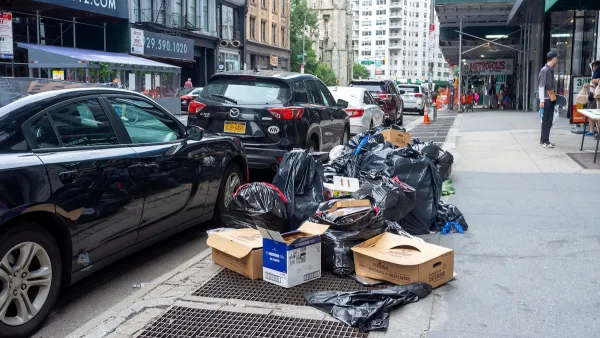Anyone who uses a bike to navigate their city knows that every ride has stretches that are much more stressful than others. A new project collects data from brainwaves to map the stress levels of bikers in New York City.
Alex Davies writes about the MindRider Map, "which is created by deploying cyclists wearing a helmet that measures their brainwaves." The resulting map provides information on "like which route would be the most relaxing, and which the most demanding of your attention."
MindRider is the work of Arlene Ducao, who developed the technology behind the idea while a graduate student at MIT.
"The setup is simple: An off-the-shelf EEG brainwave sensor made by NeuroSky is built into a standard helmet. To make the map, eight riders spent September and October riding most of Manhattan (favoring north-south thoroughfares over east-west cross streets). Every second, the EEG sensor sends, via Bluetooth, data on the rider’s level of focus. Attention level rises when the user focuses on one thing (say, a car about to swerve into the bike lane), and decreases when they’re less focused."
The article goes on to detail some of the caveats related to the data collected conducted so far—like skewed perspectives generated by a limited pool of riders and the limitations of the off-the-shelf EEG sensor. But the potential of this kind of information, and this kind of research, is also tremendous for informing planners looking to improve bike infrastructure as well as bikers planner for the least stressful route.
FULL STORY: Measuring Brainwaves to Make a New Kind of Bike Map for NYC

National Parks Layoffs Will Cause Communities to Lose Billions
Thousands of essential park workers were laid off this week, just before the busy spring break season.

Retro-silient?: America’s First “Eco-burb,” The Woodlands Turns 50
A master-planned community north of Houston offers lessons on green infrastructure and resilient design, but falls short of its founder’s lofty affordability and walkability goals.

Delivering for America Plan Will Downgrade Mail Service in at Least 49.5 Percent of Zip Codes
Republican and Democrat lawmakers criticize the plan for its disproportionate negative impact on rural communities.

Test News Post 1
This is a summary

Test News Headline 46
Test for the image on the front page.

Balancing Bombs and Butterflies: How the National Guard Protects a Rare Species
The National Guard at Fort Indiantown Gap uses GIS technology and land management strategies to balance military training with conservation efforts, ensuring the survival of the rare eastern regal fritillary butterfly.
Urban Design for Planners 1: Software Tools
This six-course series explores essential urban design concepts using open source software and equips planners with the tools they need to participate fully in the urban design process.
Planning for Universal Design
Learn the tools for implementing Universal Design in planning regulations.
EMC Planning Group, Inc.
Planetizen
Planetizen
Mpact (formerly Rail~Volution)
Great Falls Development Authority, Inc.
HUDs Office of Policy Development and Research
NYU Wagner Graduate School of Public Service





























